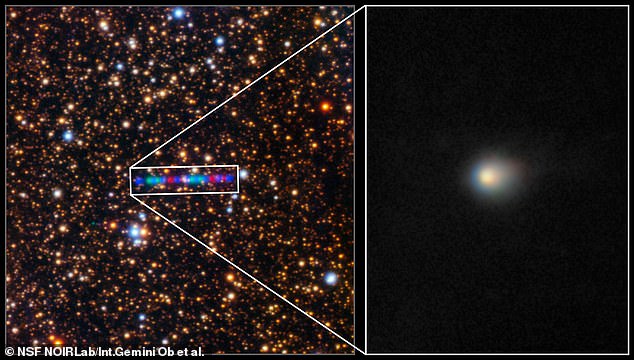By STACY LIBERATORE, US SCIENCE & TECHNOLOGY EDITOR
Published: | Updated:
Scientists are urging NASA to send a message to a mysterious interstellar object before it is too late.
The object, known as 3I/ATLAS, is traveling on a rare retrograde path and will reach its closest point to the sun on October 29, 2025, which Harvard physicist Avi Loeb suggested could be an ideal window for a covert approach on Earth.
While Loeb is not 100 percent sure 3I/ATLAS is of alien origin, he proposed communicating with it as a precaution and crafted a six-word message for the occasion.
The physicist told the Daily Mail that he wants to beam, ‘Hello, welcome to our neighborhood. Peace!’
‘The only way to reach it now is with a beam of light,’ Loeb explained, suggesting a radio message could be sent in hopes of detecting a response.
Loeb warned that if the object is an alien probe, it could reach Earth by Christmas 2025, giving humanity only months to prepare for a possible encounter.
However, he also acknowledged the risks, noting that any intelligent life aboard might see the signal as a threat.
‘A visitor to our backyard, like 3I/ATLAS, can easily enter our home planet, Earth, within a travel time of less than a few months,’ Loeb said.

NASA detected the object, dubbed 3I/ATLAS, on July 1, sparking a flurry of scientific analysis to determine its origin.
While more than 200 researchers have concluded it is likely a comet, Harvard physicist Avi Loeb has raised doubts in a newly released pre-print paper, pointing to one glaring omission: 3I/ATLAS has no visible tail.
‘There were claims of a tail,’ Loeb said, ‘but since 3I/ATLAS is accelerating and its current size is not much larger than the angular resolution of Earth-based telescopes, it is not easy to avoid fictitious elongation of the image as a result of the object’s motion.’
He also questioned the object’s unusual lack of gas emissions and its precise, retrograde trajectory, which aligns suspiciously well with the inner solar system.
Loeb has developed what he calls the ‘Loeb Scale’, a ranking system to evaluate the likelihood that an object is artificial, and gave 3I/ATLAS a six out of ten.
That suggests it is more likely than not to be engineered, though he emphasized that this score may change as more data becomes available.
‘During an exchange with 3I/ATLAS, we could use the Turing Test as a measure of the intelligence with which we communicate, as long as the two sides develop a common language for communication,’ Loeb shared in a blog post.
‘Our side of the communication channel can be assisted by our most advanced artificial intelligence systems to decode the messages we receive.


‘But as anyone who went on a blind date knows, exchanging text messages could be a very different experience than an actual encounter ‘in person.”
Among his more provocative theories, Loeb suggested 3I/ATLAS could be an alien mothership releasing small probes to intercept Earth.
‘The more likely scenario from an engineering perspective involves a mothership that releases mini-probes which perform a reverse Oberth maneuver to slow down at perihelion and intercept Earth,’ Loeb wrote.
This type of maneuver uses the sun’s gravitational pull at the object’s closest approach to adjust the trajectory efficiently, enabling the probes to reach Earth without large amounts of fuel.
Chris Lintott, an astronomer at the University of Oxford, dismissed Loeb’s theory as ‘nonsense on stilts,’ calling it ‘an insult to the exciting work going on to understand this object.’
However, Loeb said his analysis remains rooted in observational data.
His latest paper, based on ground-based telescope readings between July 2 and 29, revealed reddening colors in 3I/ATLAS, usually interpreted as surface dust or organic compounds.
Loeb noted that spectroscopic data from this and three previous studies show no signs of atomic or molecular gas in a coma, a feature typically expected in comets.
While the reddening may suggest dust, it could also mean the object simply has a naturally red surface, much like D-type asteroids or other ancient space rocks.
‘Continued monitoring around perihelion is necessary to track changes in activity and color,’ the study concluded, ‘which will provide insights into the evolution of interstellar materials under solar radiation.’








